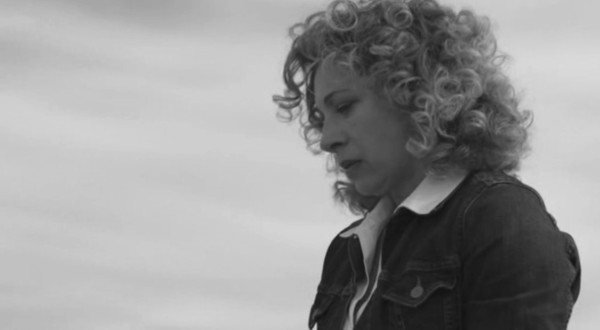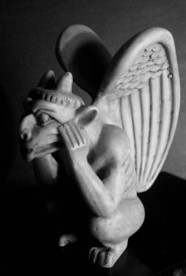I was talking yesterday about how Stephen Moffat's run on Doctor Who hasn't shirked the messianic themes of Russell T. Davies' era, and indeed has enhanced them, openly embracing an idea of 'Doctor as Christ'. Questions of faith -- not defined simply as blind belief, but as fidelity, loyalty, and faith in action -- ran through Moffat's whole first series. The final episode, taking its name from the scientific theory first formulated by perhaps the twentieth century's greatest priest-scientist, Georges Lemaître, featured a fine sequence which played on the idea of faith as 'the conviction of things not seen'.
Little Amelia Pond, in her altered universe, believes there should be stars in the almost empty night sky, and paints and draws them regularly.
'You know this is all just a story, don't you?' says a psychiatrist to her after looking at the sky by her side, 'You know there's no such thing as stars.'
Afterwards, Amy listens in on the conversation downstairs.
'I just don't want her growing up and joining one of those star cults,' says her aunt, 'I don't trust that Richard Dawkins.'
Work that one out if you can. Is this criticism of Richard Dawkins or is it praise? Is it right of his alter-ego to believe in stars, without their being any evidence of them? Does he think that they should be there, even if all the evidence points to the contrary? We don't know. All we know is that in a universe without stars, Richard Dawkins believes they're there.
An Easter hero, revisited
I talked of Paschal imagery in last year's curtain-raiser; well, watching 'The Impossible Astronaut' on the morning of Easter Sunday in Glasgow, having attended the most beautiful, vibrant, and thoughtful of vigil masses the previous night, I was struck by how Moffat seemed to be developing those ideas.
The episode begins with a image of men in what looks like late seventeenth-century garb, trying to enter a room where a painting of the Doctor has been in progress. No ordinary painting, though: instead an image of the Doctor as a heavenly king, standing in the clouds and being crowned by an angel...
It's not long before the action skips forward through the centuries to the present day where Amy and Rory receive a message, a summons from the Doctor. Off they set to the Valley of the Gods, with them arriving at their destination by bus -- a local bus, bearing the name of Utah's San Juan County, where the Valley of the Gods can be found. Yes, that's right. San Juan. Saint John. As in the fourth evangelist. Keep that in mind.
Joined by the Doctor and River, they decamp to a nearby diner, where the Doctor and River pore over their diaries, and River asks the Doctor, W'here are we? Have we done Easter Island yet?'
'Yes!' he exclaims after a thoughtful pause, 'I've got Easter Island.'
'They worshipped you there... have you seen the statues?'
'Yes!' he exclaims after a thoughtful pause, 'I've got Easter Island.'
'They worshipped you there... have you seen the statues?'
And then, after gracing us with the idea of the Doctor as God, at a place defined by the Resurrection, they set off for a picnic by a lake. But it's no ordinary picnic. It is, by any definition, a last supper, as the Doctor has summoned his friends to dine with him one last time before he goes to face his death.
That it should be by a lake seems reminiscent of Jesus' post-Resurrection meal with the Apostles by the Sea of Galilee...
That it should be by a lake seems reminiscent of Jesus' post-Resurrection meal with the Apostles by the Sea of Galilee...
... but far more important, surely, than the location of this meal is what its central element seems to be. Wine. Red wine, presumably poured by the Doctor given that he's got the bottle. The Paschal significance of this hardly needs spelling out.
'Human beings,' smiles the Doctor. 'I thought I'd never get done saving you.'
'Human beings,' smiles the Doctor. 'I thought I'd never get done saving you.'
A mysterious figure appears from the lake and the Doctor approaches it, telling his friends not to follow: 'You all need to stay back. Whatever happens now, you do not interfere. Clear?' Parallels to Jesus' instructions to his followers at Gethsemane should be very obvious at this point.
And then, having told his friends to stay back, the Doctor goes to his death, dropping his head and dying with arms outstretched as though nailed to a cross.
He collapses onto the ground, dead, and his friends gather around him. Here the iconography becomes particularly clear, with River leaning over his body, clad in blue and white, a Marian figure in a Pieta. Amy next to her is a redhead and clad in red too; as the previous year, she is Mary Magdalene. And Rory? He must, I suppose, be the beloved disciple; hardly surprising, really, given how he's basically defined by his steadfast love and loyalty. And then up turns Canton Everett Delaware III to confirm that there's definitely been no fraud and to help them dispose of the body. This old man is clearly standing in for Joseph of Arimathea.
It's important to destroy the body, for what it's worth, because as River says, 'A Timelord's body is a miracle. Even a dead one. There are whole empires out there that'd rip this world apart for just one cell.' And why shouldn't a dead body be as miraculous as a live one? Elisha's bones could raise the dead, if we can believe the Old Testament...
Note that it's River, clad in the colours of Mary, who expresses complete fidelity to the Doctor. 'We're his friends,' she says. 'We do what the Doctor's friends always do. As we're told.' Her faith is absolute. Remember what I said yesterday about early Christians seeing the Incarnation as a recasting of the Fall? Well, just as Eve's role in the Fall was defined by her disobedience, well, so Mary's role in our salvation is defined by her obedience. 'Behold, I am the handmaid of the Lord; let it be to me according to your word,' she said, and thus the Word became flesh.
Afterwards they return to the diner, the same place they'd met before the Doctor's death. It's the Cenacle, in effect, the upper room, but -- unlike earlier -- this time it's not a place of comfort and friendship. It's a place of disbelief, of confusion, of a complete lack of understanding of what has just happened.
And then, all of sudden, he's among them, and they're looking at him in horror, as though they're looking at a ghost.
He's okay, he assures them, he's the King of Okay, but they're still baffled, and then, in complete confusion, Rory stretches out his finger...
Doubting Thomas. It could hardly be more explicit, could it?












2 comments:
This is interesting, I hadn't watched it for a while. The Christian references here are pretty bvious yes. Before this, I was uncomfortable with the Messianic thing. It often feels like the Doctor is this god to fill a hole in the hearts of those who don't have/care about Our Lord...
Okay, I am somewhat more swayed by this post than by the last. I must watch out for this theme in Dr Who in future
Post a Comment